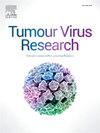hpv18诱导的果蝇模型揭示E6致癌基因调控NF-κB和Wnt抑制细胞凋亡
IF 8.1
Q1 VIROLOGY
引用次数: 0
摘要
由高风险人类乳头瘤病毒(HPV)引起的癌症仍然是一个重大的健康威胁,每年造成30多万人死亡。两种HPV癌基因E6和E7的持续表达是癌症发生和发展所必需的。E6在肿瘤发生中具有多种功能,其中之一是阻断程序性细胞死亡和细胞凋亡。E6抗细胞凋亡作用的具体机制尚不完全清楚。本研究利用果蝇HPV18E6模型和人类ube3a诱导的发病机制,我们发现E6的抗凋亡功能在果蝇中是保守的。我们证明了人类NF-κB转录因子Dorsal和Dif在果蝇中的同源物具有促凋亡作用。它们诱导无翼蛋白(Wnt,人类Wnt的果蝇同源物)的表达,导致细胞凋亡。我们的研究结果表明,E6癌基因通过下调Wg、Dorsal和Dif的表达来抑制细胞凋亡。此外,我们发现Dorsal和Dif不仅能促进细胞凋亡,还能调节细胞自噬和坏死。Dorsal促进自噬,而Dif抵消自噬,诱导酸性液泡的形成和坏死。有趣的是,尽管E6阻断了Dorsal和Dif的促凋亡功能,但它无法干扰它们在凋亡非依赖性细胞死亡中的作用。鉴于NF-κB转录因子的高度保守性,我们的研究结果为NF-κB介导的干预hpv感染细胞中E6癌蛋白永活作用的潜在机制提供了新的见解。本文章由计算机程序翻译,如有差异,请以英文原文为准。
Drosophila model of HPV18-Induced pathogenesis reveals a role for E6 oncogene in regulation of NF-κB and Wnt to inhibit apoptosis
Cancers caused by high-risk human papillomavirus (HPV) remain a significant health threat resulting in more than 300,000 deaths, annually. Persistent expression of two HPV oncogenes, E6 and E7, are necessary for cancer development and progression. E6 has several functions contributing to tumorigenesis one of which is blocking programmed cell death, apoptosis. The detailed mechanism of anti-apoptosis function of E6 is not fully understood. Here, using a Drosophila model of HPV18E6 and the human UBE3A-induced pathogenesis, we show that anti-apoptotic function of E6 is conserved in Drosophila. We demonstrate that the Drosophila homologs of human NF-κB transcription factors, Dorsal and Dif are proapoptotic. They induce the expression of Wingless (Wg, the Drosophila homolog of human Wnt), leading to apoptosis. Our results indicate that E6 oncogene inhibits apoptosis by downregulating the expression of Wg, Dorsal, and Dif. Additionally, we find that Dorsal and Dif, not only promote apoptosis but also regulate autophagy and necrosis. Dorsal promotes autophagy while Dif counteracts it, inducing the formation of acidic vacuoles and necrosis. Interestingly, although E6 blocks the proapoptotic function of Dorsal and Dif, it lacks the ability to interfere with their role in apoptosis-independent cell death. Given the high conservation of NF-κB transcription factors our results provide new insight into potential mechanisms mediated by NF-κB to intervene with cell immortalization action of E6 oncoprotein in HPV-infected cells.
求助全文
通过发布文献求助,成功后即可免费获取论文全文。
去求助
来源期刊

Tumour Virus Research
Medicine-Infectious Diseases
CiteScore
6.50
自引率
2.30%
发文量
16
审稿时长
56 days
 求助内容:
求助内容: 应助结果提醒方式:
应助结果提醒方式:


